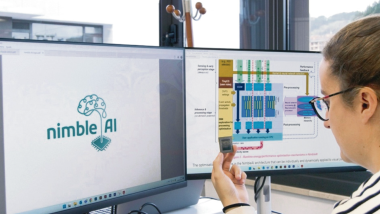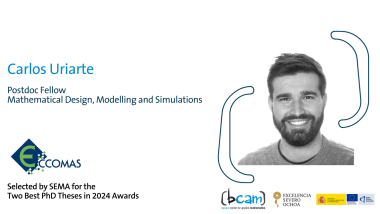Gabriela Capo will defend her doctoral thesis on Tuesday, February 12th
- The defense will take place in the Faculty of Science and Technology of the University of the Basque Country, located in the Campus of Leioa, at 11:45
Gabriela Capo joined the Basque Center for Applied Mathematics in 2015 as a PhD student (Predoc Severo Ochoa 2014 grant). She holds a Bachelor Degree in Engineering in Applied Sciences, obtained in 2012 from the Politehnica University of Bucharest, and a Master of Science in Mathematical Modeling in Engineering from the Erasmus Mundus MathMods Programme, an international two years master’s program awarding a joint diploma between University of L'Aquila (Italy), University of Nice (France) and University of Hamburg (Germany).
Her PhD thesis has been directed by Prof. Luca Gerardo-Giorda, research line leader of the Mathematical Modeling in Biosciences group in BCAM, and by Prof. Daniela Calvetti, Professor at Case Western Reserve University in Cleveland (US). During her PhD she had various short stays in the United States, summing up to a total of 6 months, during which she worked closely with Prof. Daniela Calvetti and Prof. Erkki Somersalo, well known experts in mathematical modeling of brain metabolism. On behalf of all BCAM members, we would like to wish Gabriela the best of luck in her thesis defense.
Thesis title: Computational predictive modeling of integrated cerebral metabolism, electrophysiology and hemodynamics
Understanding the energetic requirement of brain cells during resting state and during high neuronal activity is a very active research area where mathematical models have contributed significantly by providing a context for the interpretation of the experimental results. In this thesis, we present three new computational predictive mathematical models to elucidate several dynamics in the brain, comprising electrophysiological activity, cellular metabolism and hemodynamic response. Many computational challenges had to be addressed, mostly due to the very different characteristic times at which the electrical, metabolic and hemodynamic events occur. The first part of the thesis proposes a novel predictive mathematical electro-metabolic model connecting the electrophysiological activity and the metabolism through a double feedback mechanism based on energy demand and production. This model sheds light on the role of the glial potassium cleaning in brain energy metabolism by integrating a four compartment metabolic model with one describing in details the electrical activity. The results of computed experiments performed with this model for different protocols, namely awake resting state, transitions between resting state and neuronal activation and ischemic episodes are in agreement with experimental observations. In the second part of the thesis, the electro-metabolic model is expanded to comprise the brain hemodynamic response. This is attained through a triple feedback mechanism between the electro-physiology, metabolism and a three compartment hemodynamic model tracking the changes of cere- bral blood flow and cerebral blood volume through arteries, capillaries and veins. During neuronal activation, the increase in extracellular potassium concentration triggers an increase in the cerebral blood flow and concurrently vasodilation, ensuring the supply of nutrients necessary for the metabolic response to sustain the increased energy demand. The ensuing hemo-electro-metabolic model provides a better insight on the transitions between resting state and neuronal activation. In the third and last part of the thesis, we propose a variant of the electro-metabolic model that adequately describes the changes in the brain in connection with cortical spreading depression (CSD) waves. In addition the dynamics of sodium and potassium, the new model accounts for chloride dy- namics, the glutamate-glutamine cycle, as well as neuronal swelling accompanied by shrinkage of extracellular space. As illustrated with computed experiments, with this model it is possible to follow simultaneously the changes in ionic homeostasis, the alterations in the volumes of the cellular com- partments and of the extracellular space, and large modifications in brain metabolism during cortical spreading depression waves. The model predictions, in agreement with findings reported in the experimental literature, show a large decrease in glucose and oxygen concentration and a significant increase in lactate concentration during the passing of cortical spreading depression waves.
Related news
About the center
About the center




